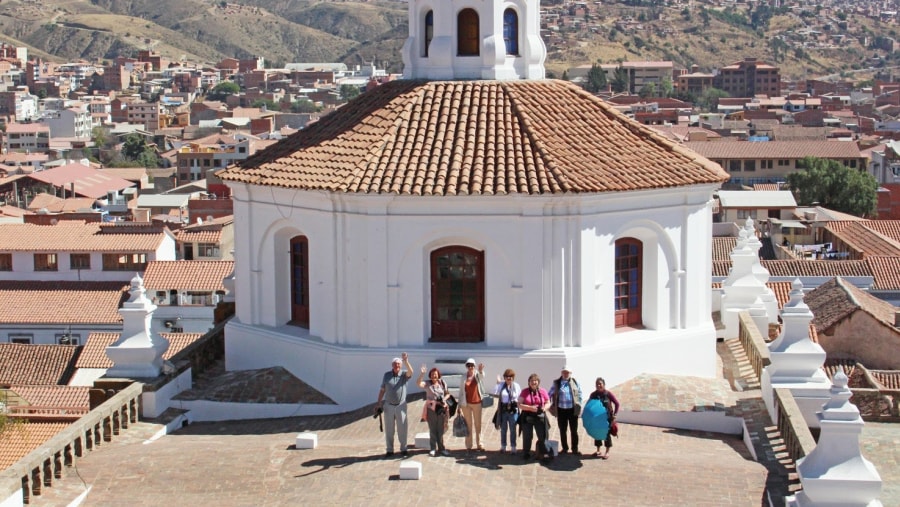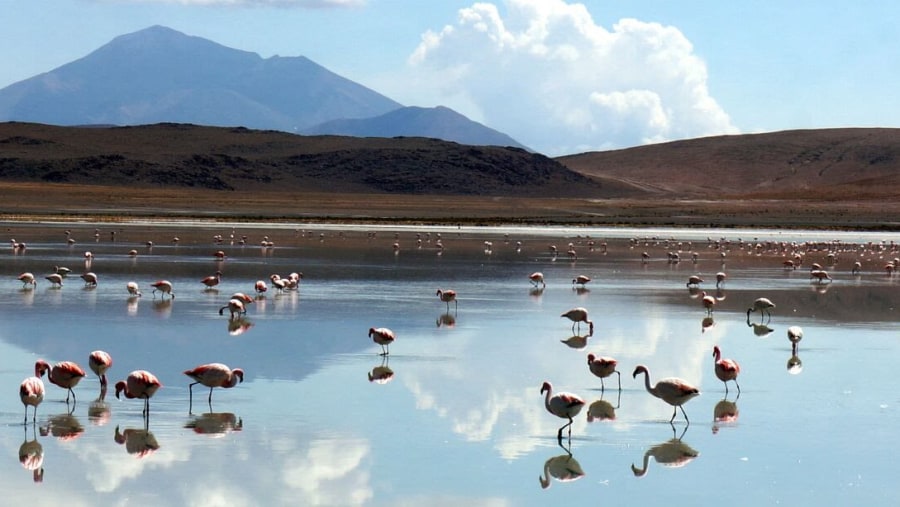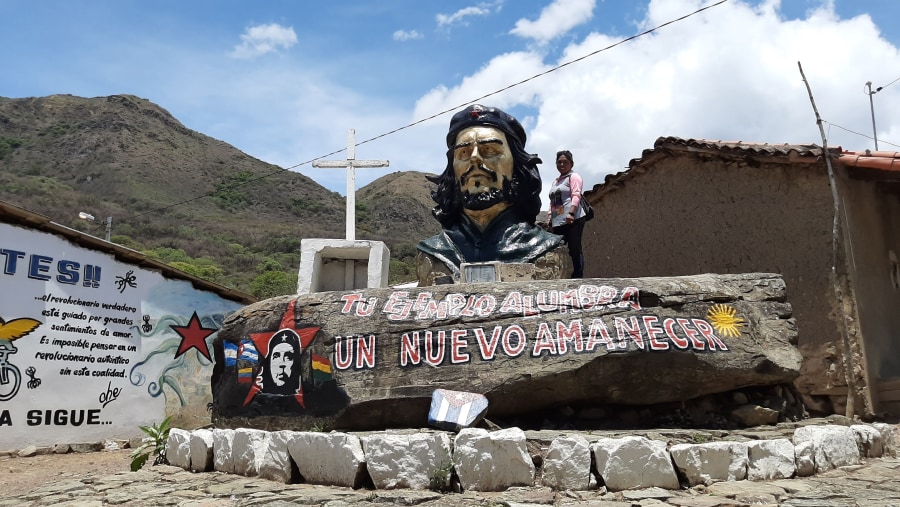15-Day Bolivia Tour
Description
Discover Bolivia's stunning landscapes in its national parks, the rich cultural heritage of our indigenous communities, the ancient history, and colonial cities. Hike to see the Giant tree ferns and spectacular landscape of Amboró National Park. Visit La Higuera and Vallegrande, where popular Che Guevara spent his lasts days. Learn about our Pre-Columbian UNESCO World Heritage Sites of El Fuerte and Tiwanaku. See beautiful landscapes from La Recoleta viewpoint overlooking UNESCO World Heritage of Sucre - Bolivia's capital city. Compare footprints at Cal Orcko with the Dinosaurs footprints. Move ahead to the colonial and silver mining UNESCO World heritage city of Potosí. Take a three-day Salar de Uyuni 4WD adventure, including the train cemetery, salt flats, Incahuasi (cactus) Island, colourful lagoons, geysers, hot springs and ancient volcanoes in Avaroa National Park. Explore the vibrant city of La Paz, including Moon Valley, witches market and ride a cable car. Wash your hands at the Eternal Youth fountain in the Isla del Sol, Lake Titikaka, and more in this 15-day tour of Bolivia.
Itinerary Expand All Collapse All
-
DAY 1: SANTA CRUZ - AMBORO NATIONAL PARK expand_more
- Transfer to Amboro (3 1/2 hours drive approx), located in the middle of Bolivian tropical jungle.
- After checking into our accommodation, we have some optional walks or if you prefer, just rest.
Included meals: breakfast, lunch dinner.
Refugio Los Volcanes.
-
DAY 2: VALLEGRANDE – CHE GUEVARA ROUTE expand_more
- After breakfast, we continue towards La Higuera.
- Stop in Pucará, a picturesque village typical of the Bolivian valleys.
- Have the option to go for a walk (4 to 6 hours activity) to find Giant Tree ferns, wildlife.
- After lunch, continue to Vallegrande and arrive 3 ½ hours later at this picturesque old town of traditional colonial architecture.
- After visiting Pucará, continue our travel to La Higuera, the site of Che´s execution.
- We will visit the ¨Che places¨ in Vallegrande: the laundry room at the hospital, where Che’s body was laid out for display to the public and the press, the Che museum, and the memorial erected at Che´s newly found burial site, which was recently found after years of mystery.
Spend the night in Vallegrande. Plaza pueblo hotel or similar.
Included meals: Breakfast, lunch 13 La Higuera and Che Guevara Route.
Return to Samaipata to spend the night.
Hotel Quinta Pirai or similar, Included meals: Breakfast, lunch.
-
DAY 3: Visit to El Fuerte expand_more
- The archaeological site of Samaipata consists of two parts: the hill with its many carvings, believed to have been the ceremonial centre of the old town (14th–16th centuries), and the area to the south of the hill which formed the administrative and residential district. The huge sculptured rock dominating the town below is a unique testimony to pre-Hispanic traditions and beliefs and has no parallel anywhere in the Americas.
- Afternoon, drive back to Santa Cruz; optional stop at the Las Cuevas waterfalls.
Hotel: Cosmopolitano or similar
Included meals: Breakfast.
-
DAY 4: FLY SANTA CRUZ - SUCRE. expand_more
- Take a short flight to Bolivia´s capital city, the Historic City of Sucre, located in the foothills of the Sica Sica and Churuquella in central-south of Bolivia, an excellent, intact and well-preserved illustration of the architectural blending achieved in Latin America through the assimilation of local traditions and styles imported from Europe. Founded by the Spanish in 1538 as Ciudad de la Plata de la Nueva Toledo (Silver Town of New Toledo) on the lands of the Yampara, indigenous culture of the Characas confederation, La Plata was for many years the judicial, religious and cultural centre of the region. The city was renamed in honour of the deceased leader of the fight for Independence, Antonio Jose de Sucre, in 1839 when it was declared the capital of Bolivia.
Hotel ON boutique or similar.
Included meals: Breakfast
-
DAY 5: SUCRE + DINOSAUR'S FOOTPRINTS expand_more
- Explore the Casa de la Libertad, where Bolivia’s Declaration of Independence was signed, houses galleries related to the city's past as the national capital.
- On Plaza 25 de Mayo, the main square, see the Catedral Metropolitana, an ornate colonial church. Nearby is the Museo Universitario Charcas USFXCH, featuring religious artifacts and contemporary art. Parque Bolivar. If we have time, we can try our traditional saltines (a type of Cornish pastry).
- Continue to Cal Orcko, located 3 miles south of downtown Sucre in Bolivia, home to the world's largest and most diverse collection of dinosaur footprints from the Cretaceous Period. The limestone cliff hosts about 12092 dinosaur footprints, with many dating back 68 million years.
Hotel ON Boutique
Included meals: Breakfast, snacks
-
DAY 6: DRIVE TO POTOSI expand_more
- After breakfast, take an early local bus to Potosi city.
- See how the landscape changes getting to the highlands and Potosi city. In the 16th century, this area was regarded as the world’s largest industrial complex. The extraction of silver ore relied on a series of hydraulic mills. The site consists of the industrial monuments of the Cerro Rico, where water is provided by an intricate system of aqueducts and artificial lakes; the colonial town with the Casa de la Moneda; the Church of San Lorenzo; several patrician houses; and the barrios mitayos, the areas where the workers lived.
- Visit Casa de la Moneda Museum, a vast, elegant, and magnificent building that takes up a whole city block. In many specialists' opinion, it is the most important building among the colonial architecture of South America. Its construction began in 1750 and concluded in 1773. The works were in charge of the manufacturer and architect Salvador de Vila. This mansion is considered a national monument and occupies a square, and stores valuable samples of paintings and sculptures, besides the furniture and other objects of historical interest. The biggest attractions in this house are the lamination machinery used to wedge coins, the main oven for silver foundry and the collection of dies for coining money. A picturesque detail is the smiling polychrome mask that is at the entrance and that had been placed there at the beginning of the War of Independence to cover a royal plate.
Hostal Santa Monica or similar.
Included meals: Breakfast
-
DAY 7: POTOSI MINE TOUR expand_more
- Take this half-day tour to the mines in Potosí for a unique opportunity to witness the miners' way of living in the world's highest city. The Cerro Rico ('rich mountain') of Potosí was famous for providing large quantities of silver and other precious minerals for Spain during colonial times. Due to this strong exploitation and harsh climate, Potosí is now one of Bolivia's poorest cities, Bolivia's poorest cities, and by taking this tour, you are supporting the local economy.
- Afternoon, take the local bus to Uyuni town (4 hours bus trip).
O'N Hostal Samaywasi or similar.
Included meals: Breakfast.
-
DAY 8: AVAROA NATIONAL PARK expand_more
- Early start today; make a quick stop at the train cemetery and head south to Siloli desert.
- Drive towards the Laguna Verde, passing through the surreal desert of Salvador Dali.
- Arriving at Laguna Verde, see the volcano Licancabur guarding the laguna.
- Continue to the Polques hot springs with the possibility of taking a quick dip into the natural bath.
- From Polques, drive towards Sol de Mañana geysers, with a stop at the bubbling fumaroles, like visiting another planet.
- Spend the afternoon visiting “Laguna Colorada” and have time to take pictures of thousands of Flamingos (James, Andean and Chilean variety).
- Our last stop is the “Arbol de Piedra” (Rock Tree formation), amazing erosions and surreal desert sceneries.
- Once we leave the National Park, enter Siloli desert and find our accomodation near the mountain of seven colours.
O'N Hotel Ojito de Perdiz - Tayka
Included meals: Breakfast, lunch, dinner
-
DAY 9: SALAR DE UYUNI expand_more
- Drive to Uyuni salt flats; on the way, we have some stops at Lagunas with different colours: Cañapa, Hedionda and Honda, the Mirador of the active volcano Ollague, small Quechua and Aymara communities.
- Next, continue to the great Salar de Uyuni, the Salt flat's blinding whiteness, the island “Isla Incahuasi”.
- Hike in the island, surrounded by the salt sea, and also home for a huge type of cacti, with exemplars over 1000 years old.
- The next stop is at the first Salt Hotel to appreciate the interesting architecture. The Salt Hotel remains now as a museum for visitors.
- Spend the rest of the afternoon enjoying the salt flats and if the weather helps, we will wait for the sunset.
O'N Hotel Palacio de Sal.
Included meals: Breakfast, lunch, dinner
-
DAY 10: FLY TO LA PAZ expand_more
- Take an hour flight to La Paz, the administrative capital of Bolivia.
- See the usual parts of the city, such as the historical government and financial districts.
- Mingle with locals, walk in the colourful markets and Valle de la luna.
Hotel Altus or similar.
Included meals: Breakfast, snacks
-
DAY 11: TIWANAKU AND TITIKAKA expand_more
- Drive to Lake Titikaka. Tiwanaku is located near the southern shores of Lake Titicaca on the Altiplano, at an altitude of 3,850 m. and at 72km from La Paz city, in the Province of Ingavi, Department of La Paz. Most of the ancient city, which was largely built from adobe, has been overlaid by the modern town.
- However, the monumental stone buildings of the ceremonial centre survive in the protected archaeological zones. Tiwanaku: Spiritual and Political Centre of the Tiwanaku Culture began as a small settlement which later flourished into a planned city between 400 A.D. and 900 A.D. The maximum expression of this culture is reflected in the civic - ceremonial organized spatially with a centre oriented toward the cardinal points, constructed with impressive ashlars stones carved accurately and equipped with a complex system of underground drainage that was controlling the flow of rain waters.
- After lunch, drive to Copacabana and lake Titikaka; 5 hours drive approx.
Hostal Las Olas or similar.
Included meals: Breakfast, lunch
-
DAY 12: ISLA DEL SOL AND ISLA DE LA LUNA expand_more
- In the morning, explore the town. Copacabana is located at the shores of Lake Titicaca, known for religious festivals and red-roofed houses. It's a base for exploring Isla del Sol and Isla de la Luna, islands with sacred Incan archaeological sites.
- Near Copacabana's main square, Plaza 2 de Febrero, see the Basilica de la Virgen de la Candelaria, a major pilgrimage site with Moorish domes and the Virgen de la Candelaria sculpture.
- After our visit to the town, we will take a motorboat to Isla del Sol, a Bolivian island in Lake Titicaca. It’s crossed by trails and known for Inca sites like PilkoKaina, with its palace and temple.
- In nearby Yumani village, the Escalera del Inca is a staircase leading to a spring once believed to prolong youth. The lake is said to be the birthplace of the first Incas; 2 hours hike to our accommodation. Possibility to enjoy an amazing sunset.
O'N Ecolodge La Estancia
Included meals: Breakfast, lunch, dinner
-
DAY 13: BACK TO LA PAZ. expand_more
- Morning back to Copacabana and La Paz city.
- Free afternoon.
Hotel Altus or similar.
Included meals: Breakfast
-
DAY 14: FREE DAY expand_more
Hotel Altus or similar.
Included meals: Breakfast
-
DAY 15: FLIGHT OUT expand_more
- Transfer to the airport.
Included meals: Breakfast (from 6:30 am to 9 am).
What's Included
- Activities, Transport, Accomodation in a twin or double room and Meals as described in the program.
- Tour Guide during the program
- Domestic flights (from Santa Cruz to Sucre and from Uyuni to La Paz)
- Entry fees
- Transfers to/from hotel to Bus station when we take local buses
- Departure transfer
What's Excluded
- International flight tickets
- Departure tax
- Drinks
- Tips
- Optional Activities
What to bring
- Light and Winter clothing
- Generally speaking, we recommend you pack as lightly as possible. You'll also need a day pack/bag for activities and day trips. In terms of weight, airlines generally allow a maximum of 20kg for check-in luggage.
- Closed-in shoes will help to protect your feet from cuts and scratches when walking through cities as well as bush/grass-lands and will also act as a barrier protection in rare cases against bites or stings
- Sun protection - hat, sunscreen, sunglasses
- Soft and/or hard copies of all important documents, e.g. air tickets, passport, vaccination certificate, etc. and keep the hard copies separate from the originals. While not valid, a copy makes it very much easier to obtain replacements, if necessary.
- Water bottle. We recommend at least a 1.5-litre capacity.
- Electrical adapter plug
- Personal medical kit and electrolytes to keep hydrated
- Insect repellent
- Watch/Alarm clock or phone that can be used for both
- Swimwear, travel towel
- Warm clothes: Thermal underclothes, windproof jacket
- Avoid unnecessary valuables; purchase a money belt or pouch that is easily hidden.
Know before you go
- Boliviano (Bob) is the local currency, but USD US Dollars are accepted (better exchange rate for big notes 100 and 50)
- Samaipata, Vallegrande, Uyuni are small towns; accommodation and facilities are basic.
- Strikes are common in Bolivia; these are generally peaceful protests, sometimes they can result in roadblocks and disruption to travel. In this event, we will amend our itinerary if necessary to minimise any impact on our program.
- The program allows for gradual acclimatisation, spending two days in Sucre (2800m) before continuing to Potosí (4060m), Salar de Uyuni (ranging from between 3650m and 4926m), La Paz (3650m) and the Isla del Sol (4000m). The maximum altitude on this trip is 4926m at Sol de Mañana geysers– please ensure that your insurance covers you up to this altitude.
- Nationals from the USA and South Africa need a visa to enter Bolivia, and we recommend you obtain this visa in advance from your nearest Bolivian consulate.
Meeting Point
Santa Cruz de la Sierra, Bolivia
Cancellation Policy
For cancellations upto 2 days before the tour -
Refund of 80% of the tour price.Price Details
| The group size and price | |
| 1 To 2 | USD 6900 Per Group |
| 3 To 4 | USD 12500 Per Group |
This is a private tour | |















